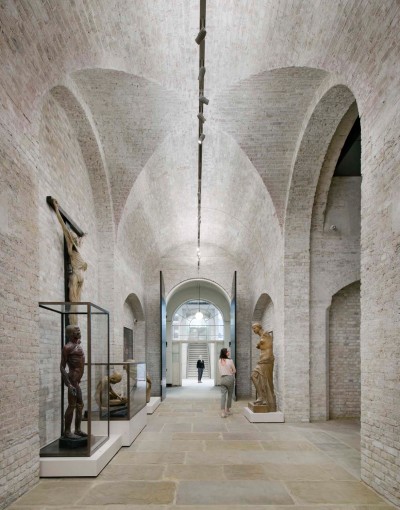David Chipperfield: “Architecture is the background”
By Laura Mark
Published 14 May 2018
As the Royal Academy opens its doors after a major redevelopment to mark our 250th birthday, we caught up with its architect, David Chipperfield RA, to hear about his vision for the new RA.
-
Tell us about the plan for the new RA
There were two challenges: one was physical, and the other was organisational. These two challenges sort of fed each other. We asked ourselves: how could the RA best use the Burlington Gardens building in a way which would help the overall idea of the Academy? And secondly, in terms of the building itself, what did it lend itself to?
It’s a huge project, but it might appear light touch. Was that important?
In a way, it’s not a big project. It’s a long project, or maybe a wide project. Its strangeness lies in the fact that it is clearly a “masterplan” – but there’s no big, iconic gesture. It is a masterplan made up of a number of interventions, and each one of these is fairly modest. It’s a three-dimensional puzzle. Some of those punctual interventions have a strong architectural form – the Weston Bridge [between Burlington House and Burlington Gardens], for example, is probably the most explicit one. Moving the bathrooms in Burlington House was a modest intervention, but actually it was an important part of the jigsaw puzzle. By moving them, we could release space for ticketing, and open up the front hall. There are other elements that are nearly invisible – and it’s not important that they’re visible. It is important that, for the next generation and the next life of the institution, these interventions allow certain things to happen that couldn’t before. This project is not about the Royal Academy saying “we need some new architecture”. It’s saying “we need to reuse this building. How do we use it?” And we use architecture as a methodology to deliver that.
How have you made the life of the Academy more visible?
The different components of the Academy – which make it an academy, and not a museum – will be much more explicit from now on. The fact that we had to transverse the RA Schools has made it clear that, from now on, everyone will know that there is an art school inside the Royal Academy. That was not well known. For the first time we have also made parts of the permanent collection more visible. Through that, there will be a greater public understanding of the role of the Academicians.
What role does the new Benjamin West Lecture Theatre play?
The original building by James Pennethorne had a lecture hall in the same location. It was one storey deeper, so it was more vertiginous than the current one. That was difficult for us to do, but we put it back in its place in a similar format. A lecture hall was part of the Royal Academy’s original ‘shopping list’. Such things tend to be dark spaces, stuck down in the basement, but we felt that it would be nice if it remained a room – that it was like a gallery, in a way. It would be a gallery with seats in it. It has an aspiration to be a public space.
-
Come to see the artistic works, not the box they come in. I’m more than happy if visitors notice it has been done well – but architecture is the background.
David Chipperfield RA
-
How do you hope the project will be received?
I hope the architectural intervention will be seamless and invisible. How the RA will be perceived is probably to do with how the project frees up programming. It means the Academy will have many more options. In the past, the RA has tended to rely on the main exhibition. But now, the experience will be more balanced: there will be more exhibitions at the same time, alongside lectures and events, and places to eat and drink. The offer will become bigger. It will change the attitude towards the building.
What did it mean to you as an Academician to do this project?
At first I thought it might be a disadvantage, but in the end I thought it was quite good. I was one of them and I knew how to receive and filter information. My fellow Academicians were very sympathetic. They know what doing a project like this is about.
What parallels are there with this project and your other work?
Projects working with old buildings often have something in common. There are strong relationships between the RA, and other work we have done with existing buildings: they share common issues. We have to develop a language and a philosophical approach. That avoids pastiche.
What details would you tell visitors to look out for?
Come to see the artistic works, not the box they come in. I’m more than happy if visitors notice it has been done well – but architecture is the background. You don’t come to the Royal Academy to see a piece of concrete – come here to see a great exhibition.
Laura Mark is Architecture Projects Manager at the Royal Academy.
-
Architecture of the new RA

The Wohl Entrance Hall

Weston Bridge and The Lovelace Courtyard

The Benjamin West Lecture Theatre

The Weston Bridge

The Julia and Hans Rausing Hall

The Wohl Entrance Hall

The Wohl Entrance Hall

The Wohl Entrance Hall











